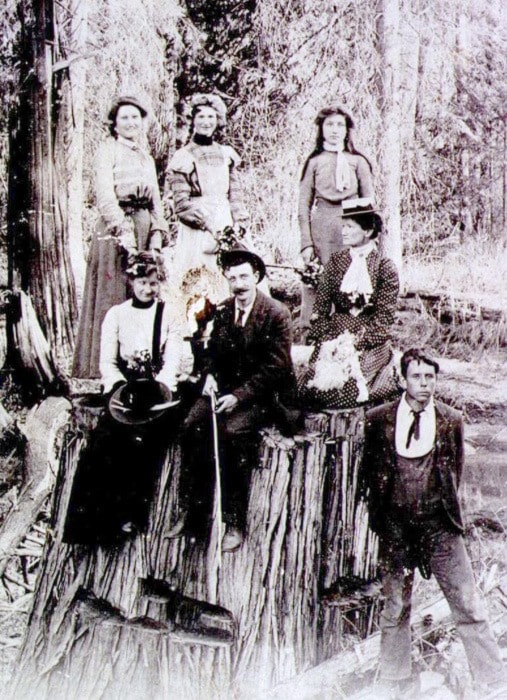A reunion to celebrate the 120th anniversary of the arrival of the Huscroft family in the Creston Valley is only a month away. In this issue, we present the continuation of an article by Donald Young, which appeared in the Creston Valley Advance in May 1958. The first part appeared in the June 30 Advance.
MAIN INTEREST GOES
Grandma Huscroft died in 1918 and with her went Grandpa’s main interest in life. He lasted four more years and in 1922 at 92 years of age he followed his beloved helpmeet to the grave. John Huscroft maintains to this day that if his father had some other interest he would have lived to well over 100.
In July 23, 1916, the Huscrofts celebrated their 60th wedding anniversary with a picnic at Huscroft. At that time all the family was living except Sarah. Today of the original family only John, Charles and Maud are alive.
At the latest count subject to correction there are 43 grandchildren, 75 great-grandchildren, 23 great-great-grandchildren and one great-great-great-grandson, and countless in-laws. The first born of six generations are as follows:
Mr. and Mrs. W.R. Huscroft, deceased
Mr. and Mrs. John Arrowsmith, deceased
Mrs. G.A.M. Young, Youngs Point, Ont.
Mr. Donald Young, Creston
Mrs. V. Rota, Riondel
Bruce Rota, Riondel
CRESTON’S BEGINNING
While the Huscrofts were settling in Huscroft, John Arrowsmith was working on the reclamation and became friendly with Fred Little and Jack Dow. They told him of their plans to pre-empt land on the east bench north of the Goat River and invited him to come in with them. Fred Little’s pre-emption consisted of 160 acres — the original townsite of Creston. Dow’s 160 acres lay to the north adjoining and the Arrowsmiths’ 80 to the south adjoining.
In the spring of 1894, the Arrowsmith family lived in a cabin on the flats west of the present home of Mrs. Effie Arrowsmith. The snowfall of the previous winter had been heavy and the spring backward. In May the weather broke. Spring was ushered in by warm winds of great force and heavy warm rain. The water on the flats rose so rapidly that the Arrowmiths were forced to evacuate their cabin in the night and seek shelter on higher ground.
This was the famous flood of 1894, which has never been surpassed since. The dykes around the Reclamation Farm were inundated and with them went Baillie-Grohman’s dream. Thirty-six years were to pass before the farm was diked again.
My grandfather, John Arrowsmith, said that when the water reached its peak that year it was almost up to where the grade of the K&S railway was later established. On more than one occasion, the old lake steamer Ainsworth tied up in front of what is now Mrs. Effie Arrowsmith’s house.
When the Arrowsmiths first arrived in the valley, their livestock consisted of one horse (the others had died along the way), two cows and several chickens. Mrs. Arrowsmith managed to raise a brood of chickens from a setting hen on the way up from Utah.
Life was not easy for these pioneers. In addition to clearing their land and making a living for themselves and their growing families they were confronted with the problem of educating the older ones. The nearest school was Kaslo so the family moved there for a few years.
CRESTON GROWS
Meanwhile, Creston was growing. Railroad construction camps of both the CPR and Great Northern had creating a flourishing business along what is now Little Avenue. Faas and Crawford had stores there as did R.S. Bevan. R.J. Long had a hotel at the north end near the old Bentley place and George Munro one at the south end.
The Arrowsmiths learned that their children of school age added to the others resident in the valley made enough to warrant a school, so they returned to Creston. The first schoolhouse was in the old Varnimo Hotel situated between Munro’s and Long’s hotels. The first teacher was Miss Dalby. Os Arrowsmith states that he is positive that this was the first school because of the following incident: He glanced out of the school window one morning and saw the town drunk proudly bearing a potted plant under each arm, heading north in the direction of Bob Long’s hotel. In hot pursuit was Geo. Munro, from whose hotel the plants had been stolen. Munro collared the culprit before he could complete his nefarious design of trading them to Bob Long for a morning “eye-opener”. With Munro in stern attendance, the drunk was forced to retrace his steps in ignominy and return to the stolen objects to their original resting places.
Soon after his return from Kaslo, John Arrowsmith built a saloon on his property but the venture was none-too-successful and he soon gave all his attention to farming to which he was more suited.
Arrowsmiths owned the first hay rake and first mowing machine in the valley. The rake is still in use in Yahk.
POSTSCRIPTS
At one time, the Arrowsmiths and Albert Jefferson owned most of the land in Arrow Creek where one of the Arrowsmith sons, Osman, farms a large tract today.
John Arrowsmith died in 1935 at the age of 75. His wife lived another 10 years and passed away in 1945 at the age of 85. Of the original seven children, five are still living. There are 10 grandchildren, 29 great-grandchildren and one great-great-grandchild surviving.
